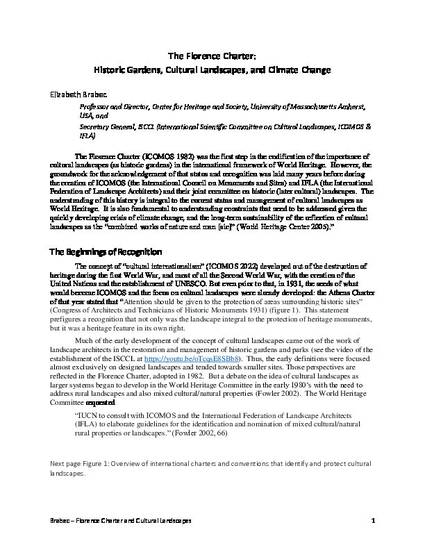
Article
The Florence Charter: Historic Gardens, Cultural Landscapes, and Climate Change
Special Session on Cultural Landscapes of the 58th IFLA World Congress Gwangju, Korea
(2022)
Abstract
The Florence Charter (ICOMOS 1982) was the first codification of the importance of cultural landscapes (as historic gardens) in the international framework of World Heritage. However, the ground work for the acknowledgement of that status and recognition was laid many years before during the creation of ICOMOS (the International Council on Monuments and Sites) and IFLA (the International Federation of Landscape Architects). The understanding of this history is integral to the current status and management of cultural landscapes as World Heritage. It is also fundamental to understanding constraints that need to be addressed given the quickly developing crisis of climate change, and the long-term sustainability of the reflection of cultural landscapes as the “combined works of nature and man [sic]” (World Heritage Center 2005).”
The concept of “cultural internationalism” (ICOMOS 2022) developed out of the destruction of heritage during the first World War, and most of all the Second World War, with the creation of the United Nations and the establishment of UNESCO. But by 1931, the seeds of what would become ICOMOS and the focus on cultural landscapes were already developed: the Athens Charter of that year stated that “Attention should be given to the protection of areas surrounding historic sites” (Congress of Architects and Technicians of Historic Monuments 1931).
Much of the development of the concept of cultural landscapes came out of the work of landscape architects in the restoration and management of historic gardens and parks. Thus, the early definitions were focused exclusively on designed landscapes, and tended towards smaller sites. Those perspectives are reflected in the Florence Charter, adopted in 1982. But by the 1990’s there was an increasing need to expand the idea of cultural landscapes to include the broader ideas and expressions of cultural heritage in the landscape. Thus, in 2005 the Operational Guidelines for the implementation of the World Heritage Convention were expanded to include a new definition of cultural landscapes as
“illustrative of the evolution of human society and settlement over time, under the influence of the physical constraints and/or opportunities presented by their natural environment and of successive social, economic and cultural forces, both external and internal” (World Heritage Center 2005).
But at the same time, as the definitions expanded, problems were also coming to light with various issues around cultural landscape identification, protection and management. While cultural landscapes were initially identified as “monuments,” this designation and the structure of World Heritage inscriptions posed distinct challenges. These included a lack of capacity for identification and nomination, restricted resources and weak institutions for management, and difficulty in sustaining an inherently changing system, particularly within traditional land uses as a part of Outstanding Universal Value (World Heritage 2002).
In the intervening years, as climate change has been declared a global emergency, these issues in the Florence Charter and the Operational Guidelines have only become more critical. Change is inherent in natural systems, but the change expected around the world in cultural landscapes will be unprecedented. Each site will be challenged to maintain its characteristics of outstanding universal value, while at the same time providing a repository of culture, heritage and technological innovation. It is particularly the technological innovation reflected in cultural landscapes that have existed and thrived for extended periods of time that may become valuable as they are applied to new sites and landscapes to solve emerging issues.
This presentation will explore the current status of the nomination and inscription of World Heritage cultural landscapes, looking the historical changes and emerging challenges. The presentation will also explore how cultural landscapes, particularly World Heritage sites may provide both a repository of knowledge and a laboratory for managing and mitigating climate change impacts.
Keywords
- cultural landscapes,
- World Heritage list,
- Florence Charter
Disciplines
Publication Date
August 31, 2022
Citation Information
Brabec, Elizabeth. 2022. The Florence Charter: Historic Gardens, Cultural Landscapes, and Climate Change. In Special Session on Cultural Landscapes of the 58th IFLA World Congress Gwangju, Korea, August 31, 2022. 7pp.
Creative Commons license

This work is licensed under a Creative Commons CC_BY-NC-ND International License.
